 W
WBuffalopterus is a prehistoric eurypterid from the Silurian-aged Bertie Formation of New York and Ontario. The genus contains one species, B. pustulosus. It is closely related to Strobilopterus, but differs primarily by having a bizarre, globular telson, and in size, being estimated to be at least 1 meter in length.
 W
WCarcinosomatidae is a family of extinct arthropods in the class Eurypterida. These eurypterids are found from the Silurian to the Devonian periods. The family contains four genera; Carcinosoma, Eocarcinosoma, Eusarcana and Rhinocarcinosoma.
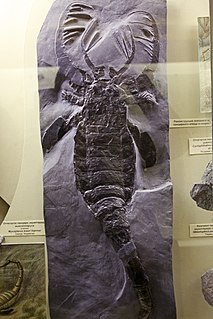 W
WCarcinosomatoidea is an extinct superfamily of eurypterids, an extinct group of chelicerate arthropods commonly known as "sea scorpions". It is one of the superfamilies classified as part of the suborder Eurypterina.
 W
WClarkeipterus is a genus of prehistoric eurypterid classified as part of the family Dolichopteridae. The genus contains two species, C. otisius and C. testudineus, both from the Silurian Bertie Formation of the United States.
 W
WCtenopterus is a genus of prehistoric eurypterid of the family Stylonuridae. It contains only one species, Ctenopterus cestrotus from the Early Silurian of Otisville, New York.
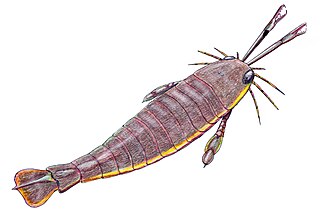 W
WDiploperculata is an infraorder of eurypterids, an extinct group of aquatic arthropods commonly known as "sea scorpions". The name, derived from Greek διπλόω ("double") and operculum, refers to the distinguishing feature that unites the superfamilies included in the group, that the genital operculum is made up of two fused segments.
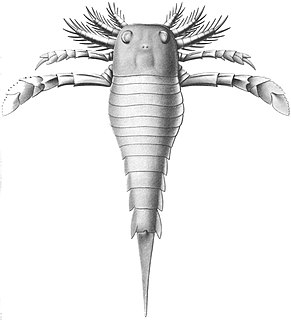 W
WDolichopteridae is an extinct family of eurypterids that lived in the Silurian and Devonian periods.
 W
WDolichopterus is a genus of prehistoric sea scorpions, arthropods in the order Eurypterida. Fossils of Dolichopterus have been discovered in deposits ranging from Silurian to Devonian, and have been referred to several different species, some of them of dubious affinity to this genus.
 W
WEchinognathus is a genus of eurypterid, an extinct group of aquatic arthropods. Classified as part of the family Megalograptidae, the genus contains one only species, E. clevelandi, whose fossils have been found in deposits from the Katian age of the Late Ordovician period of New York. The name of the species, clevelandi, honors William N. Cleveland, who found the specimens that were used for the description of Echinognathus.
 W
WErieopterus is a genus of prehistoric eurypterid found in Silurian to Devonian-aged marine strata of Europe and North America. The genus contains eight species from the Silurian to the Devonian, recovered from both North America and Europe.
 W
WEurypteridae is an extinct family of eurypterids that lived in the Silurian and Devonian periods. The family is one of three families contained in the superfamily Eurypteroidea, which in turn is one of the superfamilies classified as part of the suborder Eurypterina. The family contains two genera, Erieopterus and Eurypterus.
 W
WEurypteroidea are an extinct superfamily of eurypterids. It contains three families and two genera of uncertain classification, Paraeurypterus and Pentlandopterus.
 W
WHallipterus is a genus of prehistoric eurypterid classified as part of the family Hardieopteridae.
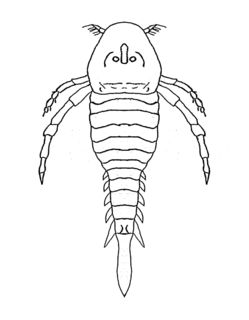 W
WThe Hardieopteridae are a family of eurypterids, an extinct group of chelicerate arthropods commonly known as "sea scorpions". The family is one of two families contained in the superfamily Kokomopteroidea, which in turn is one of four superfamilies classified as part of the suborder Stylonurina. Hardieopterids have been recovered from deposits of Early Silurian to Late Devonian age in the United States and the United Kingdom.
 W
WHardieopterus is a genus of prehistoric eurypterid classified within the family Hardieopteridae. The genus contains four species, all Silurian in age; H. lanarkensis and H. macrophthalmus from Scotland, H. megalops from England and H. myops from the United States.
 W
WHastimima is a genus of prehistoric eurypterid of the family Mycteroptidae. It contains one valid species, Hastimima whitei, recovered from the Permian Hermit Shale of Arizona, and one dubious species, H. sewardi, from the Devonian of South Africa. Though clearly a mycteropoid eurypterid, the material referred to H. sewardi is so fragmentary that it is questionable if it possesses any diagnostic value at all.
 W
WThe Kokomopteridae are a family of eurypterids, an extinct group of chelicerate arthropods commonly known as "sea scorpions". The family is one of two families contained in the superfamily Kokomopteroidea, which in turn is one of four superfamilies classified as part of the suborder Stylonurina.
 W
WKokomopteroidea is an extinct superfamily of eurypterids, an extinct group of chelicerate arthropods commonly known as "sea scorpions". It is one of four superfamilies classified as part of the suborder Stylonurina. Kokomopteroids have been recovered from deposits of Early Silurian to Late Devonian age in the United States and the United Kingdom.
 W
WKokomopterus is a genus of prehistoric eurypterid. The genus contains a single species, Kokomopterus longicaudatus, known from the Silurian of Kokomo, Indiana.
 W
WLanarkopterus is a genus of prehistoric eurypterid with one recognised species, Lanarkopterus dolichoschelus. Lanarkopterus was long seen as a species of the closely related Mixopterus, though more complete specimens discovered in the 1960s determined that it differed in several aspects, enough to warrant a separate genus.
 W
WLaurieipterus is a genus of a eurypterid classified as part of the family Stylonuridae. It contains one species, L. elegans from the Early Silurian of Scotland.
 W
WMegalograptidae are a family of eurypterids, an extinct group of chelicerate arthropods commonly known as "sea scorpions".
 W
WThe Mixopteridae are a family of eurypterids, an extinct group of chelicerate arthropods commonly known as "sea scorpions". The family is one of two families contained in the superfamily Carcinosomatoidea, which in turn is one of the superfamilies classified as part of the suborder Eurypterina.
 W
WMoselopteridae are an extinct family of eurypterids. It is the only family classified as part of the superfamily Moselopteroidea, and contains three genera: Moselopterus, Stoermeropterus and Vinetopterus.
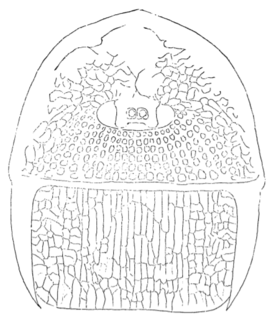 W
WMycterops is a genus of prehistoric eurypterid of the family Mycteroptidae. Mycterops lived during the Carboniferous period in Europe and North America.
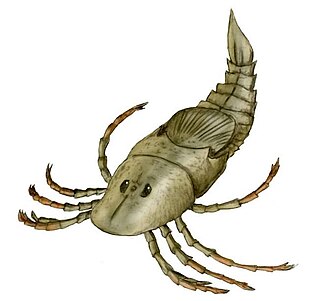 W
WMycteroptidae are a family of eurypterids, a group of extinct chelicerate arthropods commonly known as "sea scorpions". The family is one of three families contained in the superfamily Mycteropoidea, which in turn is one of four superfamilies classified as part of the suborder Stylonurina.
 W
WOnychopterellidae are an extinct family of eurypterids. The family is the only family classified as part of the superfamily Onychopterelloidea. Genera included are Alkenopterus, Onychopterella and Tylopterella.
 W
WPagea is a genus of prehistoric eurypterid classified as part of the family Stylonuridae. It contains three species, all from the Devonian; P. plotnicki from Nunavut, Canada and P. sturrocki and P. symondsii from the Old Red Sandstone of the United Kingdom. The genus is named in honor of David Page, an early worker on the fauna of the Old Red Sandstone and describer of the first Stylonurine eurypterid.
 W
WPalmichnium is an ichnofossil genus, interpreted as a eurypterid trackway. It has been found by many places around the world, such as Australia, Canada, United States or Wales.
 W
WThe Parastylonuridae are a family of eurypterids, an extinct group of chelicerate arthropods commonly known as "sea scorpions". The family is one of two families contained in the superfamily Stylonuroidea, which in turn is one of four superfamilies classified as part of the suborder Stylonurina.
 W
WRhenopterus is an extinct prehistoric eurypterid. Fossils of Rhenopterus have been recovered from deposits of Lower Devonian age in Germany.
 W
WRhinocarcinosoma is a genus of Silurian eurypterid, with a triangular carapace, laterally positioned eyes, and a curved telson. It is classified as part of the family Carcinosomatidae and contains three species, two from New York, United States and R. dosonensis, a species described in 2002 from the Dô Son Formation of the Dô Son Peninsula of northern Vietnam.
 W
WRuedemannipterus is a genus of prehistoric eurypterid classified as part of the family Dolichopteridae. The genus contains one species, R. stylonuroides, known from the Silurian of New York.
 W
WStoermeropterus is a genus of prehistoric eurypterid from the Silurian period in Europe and North America classified as part of the Moselopteridae family. The genus contains three species, S. conicus and S. latus from Ringerike, Norway and S. nodosus from West Virginia.
 W
WStrobilopteridae is an extinct family of eurypterids that lived in the Silurian and Devonian periods. The family is one of three families contained in the superfamily Eurypteroidea, which in turn is one of the superfamilies classified as part of the suborder Eurypterina. The family contains two genera, Buffalopterus and Strobilopterus.
 W
WStrobilopterus is a genus of prehistoric eurypterid of the family Strobilopteridae. The genus contains four species, two from the Devonian of Wyoming, United States, one from the Devonian of Ohio, United States and one from the Silurian of Estonia.
 W
WStylonuridae is a family of eurypterids, an extinct group of chelicerate arthropods commonly known as "sea scorpions". The family is one of two families contained in the superfamily Stylonuroidea, which in turn is one of four superfamilies classified as part of the suborder Stylonurina.
 W
WStylonurus is a genus of prehistoric eurypterid of the family Stylonuridae. The genus contains three species: Stylonurus powriensis from the Devonian of Scotland, Stylonurus shaffneri from the Devonian of Pennsylvania and Stylonurus perspicillum from the Devonian of Germany.
 W
WWaeringopterus is a genus of prehistoric eurypterids from the Silurian of North America. The genus contains two species, W. apfeli from New York and Ontario and W. cumberlandicus from West Virginia.